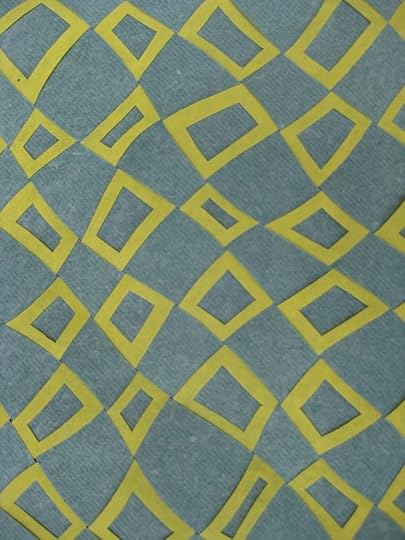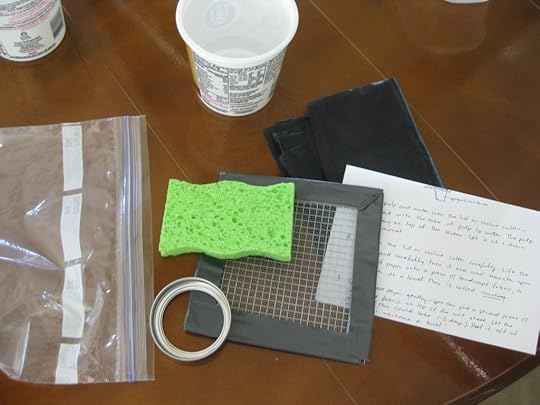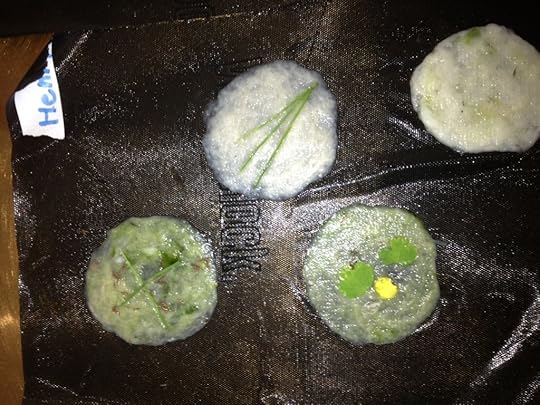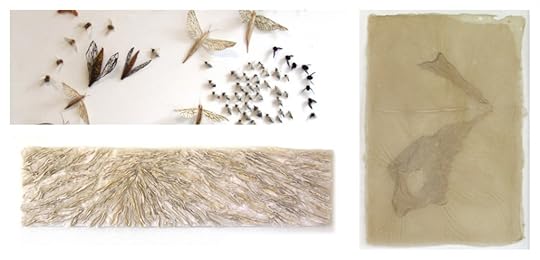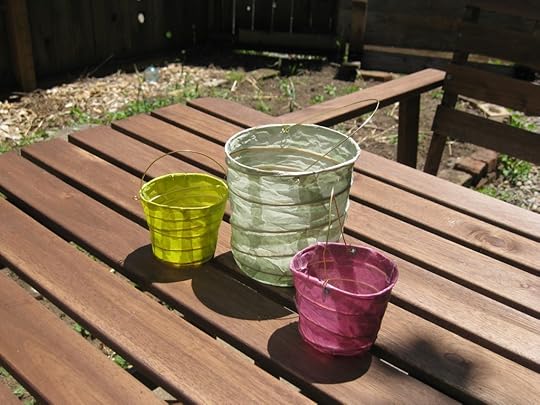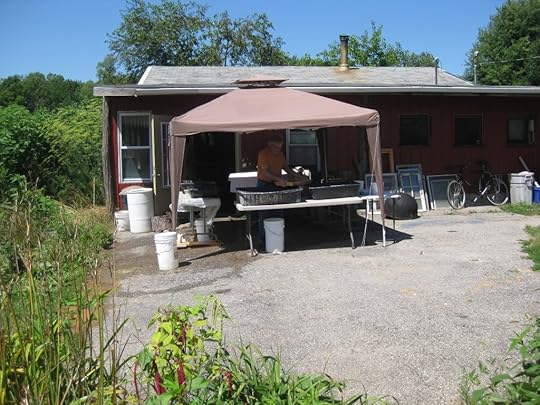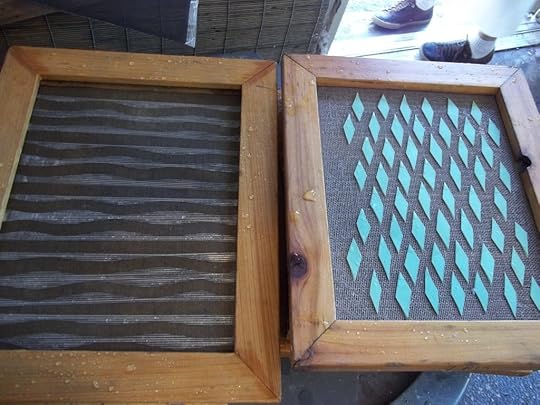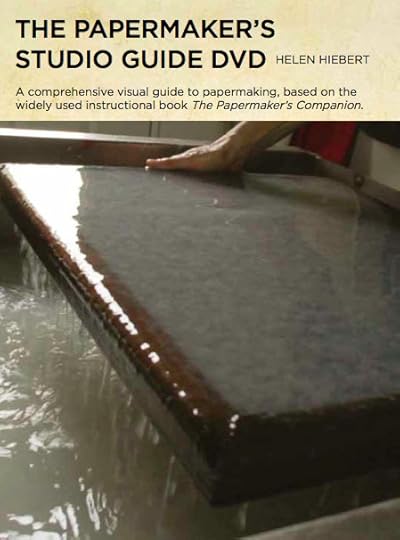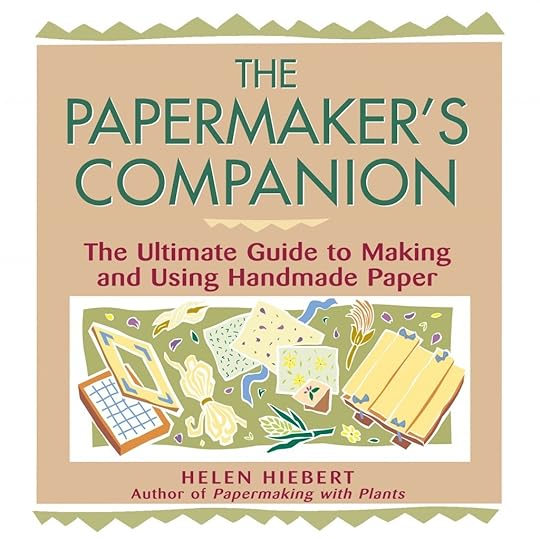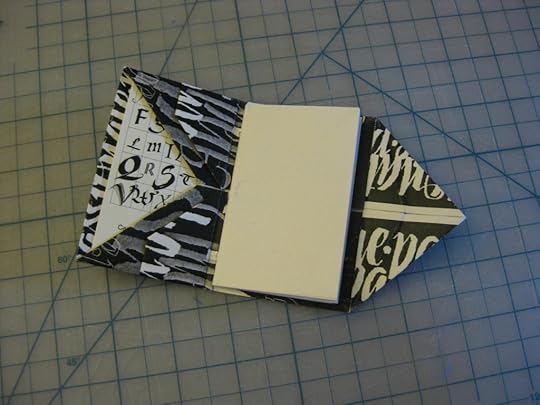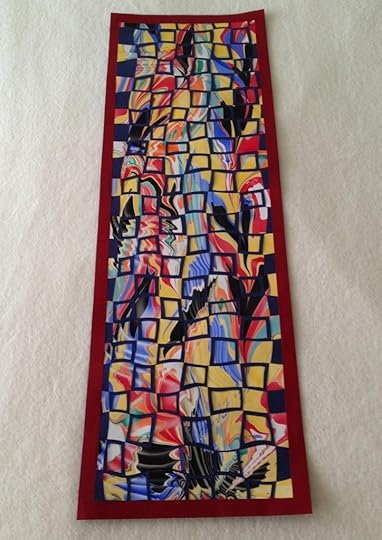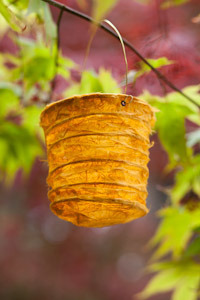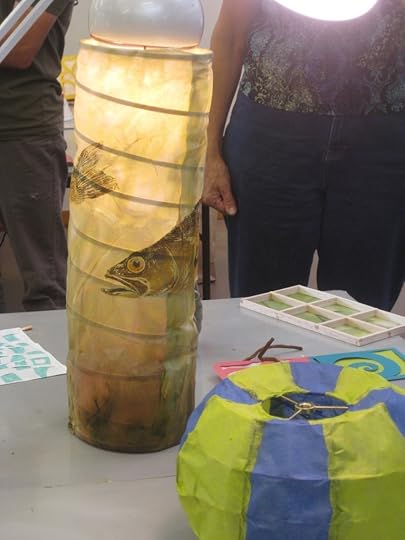Helen Hiebert's Blog, page 69
September 27, 2013
By the Light of the Moon
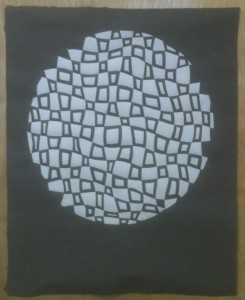
©2013 Helen Hiebert
The Morgan Conservatory of Art, a fantastic papermaking institution in Cleveland, Ohio, indirectly inspired the 100 x 100 Paper Weavings Project. Early this summer, they sent me two pieces of handmade paper and requested that I make a piece for their auction (it is tomorrow night for those of you in the area). After studying both papers, I decided that weaving would be a good way to join them, and the colors reminded me of moonlight.

© 1996 Helen Hiebert, Woven Shades with light OFF
I started thinking about the paper weavings I’ve done over the years, and there are some subtle nuances to be recognized and experimented with. Like this: look what happens to these woven lampshades when you turn the light on.

©1996 Helen Hiebert, Woven Shades with light ON
The two papers blend together and you don’t see any distinction. I find it really interesting that the space between the woven pieces (the paper slits) are highlighted by illumination.
Here are the latest 100 x 100 Paper Weavings:
#3
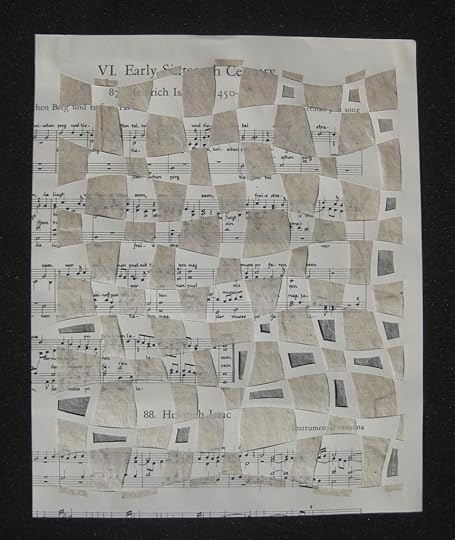
© 2013 Helen Hiebert, 100 x 100 Paper Weavings #3, 10″ x 8″, $100
When I first posted about this project, artist Sarah Strong offered to send me some papers. I received a lovely package filled with encyclopedia pages, sheet music, German bible pages and a book about ships. I coupled this sheet music with a piece of my own handmade kozo paper.
Now I have to admit that despite a couple of workshops in Japanese papermaking, I am nowhere near expert status. I tend to agree with Malcolm Gladwell’s 10,000 hour rule and take solice in the fact that I have not performed my 10,000 hours with kozo.
That said, paper weaving can hide imperfection. If you look closely at this weaving, you can see that the paper fades from top to bottom. This is due to the fact that the sheet is thicker at the top than the bottom. If you are familiar with Japanese papermaking (this link is a video by Tatiana Ginsberg demonstrating the technique), you’ll understand how this could easily happen.
#4
[image error]
© 2013 Helen Hiebert, 100 x 100 Paper Weavings #4, 10″ x 8″, $100
When I was in Minneapolis a year or so ago, I had the pleasure of visiting Wet Paint, an art supply store in St. Paul, and perusing their fabulous paper selection. This weaving is a blend of two papers that I purchased there: crystal metal (which, by the way, was a challenge to photograph) and electric zigzag lokta Paper.

electric zigzag lokta paper, perrier green
The lokta paper is made from the inner bark of the Nepalese Daphne plant. You can find lokta papers in a variety of solid-colors as well as printed patterns. This one is made by crumpling a large sheet until it is reduced to a two-inch square and then dipping selected points in dye. The crumpling also makes the paper very soft and cloth-like.

© 2013 Helen Hiebert, 100 x 100 Paper Weavings #5, 10″ x 8″, $100
Today’s weaving utilizes the old photographic technique of van dyke printing. My friend and fellow Penland instructor Alyssa C. Salomon created these two prints on some of my handmade abaca paper. The bird stood alone on a white sheet and the grasses were printed on a green sheet. I decided to weave in a bamboo branch for hanging.
There are still a few days left to enter the drawing to win a copy of my book, Playing With Paper (the drawing will take place 10/2/13. Leave a comment below telling us about your favorite type of paper to join in the fun! Many thanks to those of you who commented on the last post – feel free to comment again to get a second chance.
I’ve started a pinterest board featuring this week’s five paper weavings. Check back each day I post on the blog as new ones are added.
Related Posts
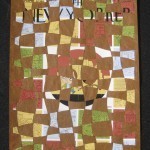 100 x 100 Paper Weavings + A Contest
100 x 100 Paper Weavings + A Contest
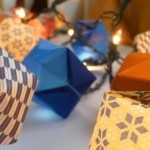 7: Inflatable Paper
7: Inflatable Paper
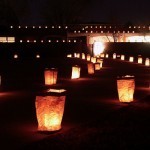 2: Paper Lights!
2: Paper Lights!
 18: Pop-Ups
18: Pop-Ups
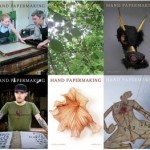 Support Hand Papermaking!
Support Hand Papermaking!
September 24, 2013
100 x 100 Paper Weavings + A Contest
To my regular readers, a quick note to let you know that I will be blogging on Tuesdays and Fridays through the end of the year. I hope you don’t mind me showing up in your in-box twice as often.
I launched my 100 x 100 Paper Weavings project yesterday, and I’ll be creating a small paper weaving each day for the next 99 days. You can read more about my thinking behind the project here and sign up to receive my blog updates by entering your e-mail in the subscribe box at the right. I’ll also be hosting a few contests throughout the duration of the project, and you can read below to find out about the first one! Today is Day 2.
#1

© 2013 Helen Hiebert, 100 x 100: #1, 10″ x 8″, $100
This magazine was laying on our table, and I noticed that the publication date was September 23, 2013, the start date for the project. The significance of this date is that 100 days from it marks the end of 2013, so it’s a count down to the end of 2013 as well!
One of my goals with this project is to write about some of the amazing papers that are out there, and my plan is to feature a unique paper, papermaker, paper store or paper technique in each of the weavings.
I paired this New Yorker cover with a Hark! Handmade Paper. This company produces small editions of high quality flax/linen/abaca papers, often commissioned for specific projects. The papers are externally coated with saturated color, followed by a patina of walnut dye, and finally a heavy coat of gelatin size. They are sturdy, come in a variety of colors and look a bit like leather.
Do you notice something distinctive about the paper that tells you it is handmade? Leave your comment below to be entered in a drawing (see details at the bottom of this post).
I chose this magazine cover for several reasons: I lived in NYC for 11 years and had many adventures with young men, including the one who became my husband (and worked at the New Yorker)! I also rode my bike all around the city and over the Brooklyn Bridge hundreds of times (there it is in the picture!). Click here to flip through each of the illustrations by Ivan Brunetti and read a description about each scene.
#2
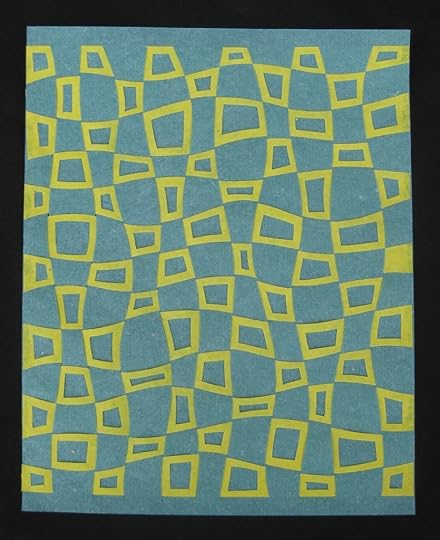
© 2013 Helen Hiebert, 100 x 100 Paper Weavings #2, $100
I’m enjoying looking through all of the papers in my flat files. This is a weaving of two sheets of my own pigmented abaca paper. Abaca is an incredibly strong and translucent fiber found in the trunk and leaf stalks of a non-fruitbearing banana plant that grows primarily in the Philippines. It is used in the manufacture of tea bags. I’m not sure what possessed me to make this garish yellow paper, but I find that it works really well with the blue.
This piece contains an added dimension. Can you see what I’ve done? What do you think the other side of the paper looks like (hint, I did not do anything extra on the back). Leave your answer in the comment section below to be entered in a contest to win a copy of my book, Playing With Paper (one of the projects in the book is a woven table runner, which features this technique).
In order to win, you must leave a comment and be subscribed to this blog. Your answer does not have to be correct, but it does have to be sincere. Entries can be submitted until Day 10, October 2, 2013. The winner will be announced that day. Good luck!
Related Posts
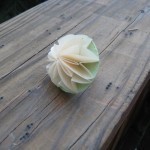 Another Giveaway!
Another Giveaway!
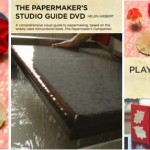 10: Paper Jewelry + A Giveaway
10: Paper Jewelry + A Giveaway
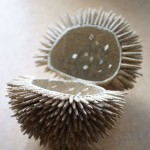 15: Rolled, Crimped, Scrunched & Wrapped
15: Rolled, Crimped, Scrunched & Wrapped
 18: Pop-Ups
18: Pop-Ups
 7: Inflatable Paper
7: Inflatable Paper
September 17, 2013
Kids Workshop at Walking Mountains
A couple of weeks ago, I had the pleasure of leading a papermaking workshop for children (and their parents) at Walking Mountains Science Center here in Avon, Colorado. I tried some new things, taking advantage of the location. We started with a quick demonstration and then headed outside to collect plant parts to include in our papers.
 The center has a lovely nature trail, and honestly, I think those kids could have spent the entire time looking at plants and cutting small pieces to put in their papers.
The center has a lovely nature trail, and honestly, I think those kids could have spent the entire time looking at plants and cutting small pieces to put in their papers.

We ended our nature hike by discovering a small snake and then headed back inside to make paper.
I brought some cooked kozo which kids could pound in a corner, but otherwise I’d prepared all of the kozo, cotton and abaca pulps. I showed the kids how to make recycled paper in a blender, so that they could try it at home. Walking Mountains prepared and gave participants small papermaking kits to take home, which included a quart-sized yogurt container, a screen (the mould), the lid of a ball jar (the deckle), a few sheets of landscaping fabric for couching, a sponge and instructions.
The kids made shaped papers using the ball jar lids and cookie cutters and utilizing Arnold Grummer’s tin can papermaking method.
I have not figured out how to send people home with dry paper yet, so they sponge pressed their sheets and stacked them on newspaper.
I’d love to hear about your methods for teaching papermaking to kids. What works? What doesn’t?
And if you are in the area, I’ll be at Walking Mountains again next week for an adult event called The Science Behind Papermaking on Wednesday, September 25th, from 6:30-8:30pm.
A big thanks to Amber Prince for most of these photos!
Related Posts
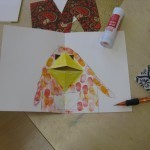 The Paper Club
The Paper Club
 Columbia College Chicago
Columbia College Chicago
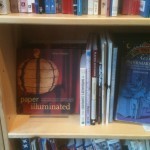 On the Bookshelf
On the Bookshelf
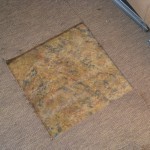 The Papermaker’s Wet Floor
The Papermaker’s Wet Floor
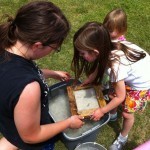 Intern in the Studio!
Intern in the Studio!
September 3, 2013
Artist Profile: Sarah Horowitz

Cirsium Vulgare by Sarah Horowitz, 18 x 11.5, sumi ink on dyed kozo
I met the artist Sarah Horowitz in Portland a few years ago and immediately felt a kinship. Later we learned that we share the same birthday (although I could have been Sarah’s babysitter)! Sarah’s exhibition Briar Roses opens this Thursday (September 5th) at Froelick Gallery in Portland, featuring a series of new drawings on paper.
Sarah applies surface treatments to almost all of the papers she uses. Her introduction to paper as a substrate came through printmaking (she does exquisite etchings and often utilizes chine colle). She became familiar with Japanese papers which are strong, thin and hold up to getting wet (a necessary step in the etching process).
When she started to draw with a quill on paper, the surface became an issue. A sharp quill works best on a smooth surface because the quill doesn’t catch on the fibers. In addition, the paper needs to sized so that the ink doesn’t bleed. Someone introduced her to a paper dyed with kakishibu (a traditional Japanese persimmon dye) which in addition to coloring the paper acts as a waterproofing agent, similar to sizing.
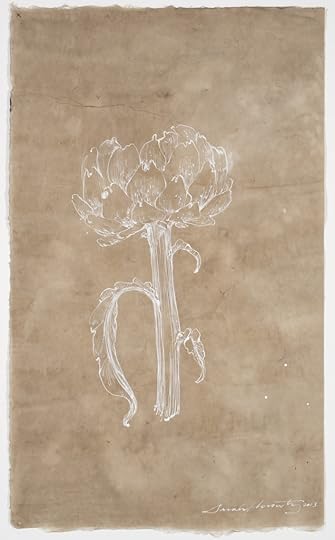
White Artichoke by Sarah Horowitz, 17 x 10, white ink on dyed paper
Soon Sarah started making her own inks (iron gall and walnut) for dyeing kozo, mitsumata and gampi papers, which she purchases primarily from Hiromi Paper. These give her shades for tinting the paper; next she applies gelatin sizing; and finally she draws with sumi inks which are heavily pigmented and sit well on top of the dyed paper surface.

Poem by Paul Auster. Sumi ink drawing on hand-dyed kozo paper by Sarah Horowitz. 2012,
10.5 x 17 inches, cased in a clam shell box, edition of 20.
Sarah also creates artists books. The paper for her book Effigies was dyed in a big vat of indigo, which she heated and dipped long sheets of kozo through. She hung them to dry and spent the next year gelatin sizing all of the paper for the edition. Every drawing in the edition is done by hand.
FYI, Sarah does not size her papers for printmaking, since etching requires properties that are opposite from drawing: the paper needs to be absorbent and the thick oil based inks she uses do not bleed.
For her book Archeaologies of Loss, Sarah printed etchings on thin transparent sheets of gampi which she affixed to larger sheets of Somerset paper using chine colle (with rice paste).
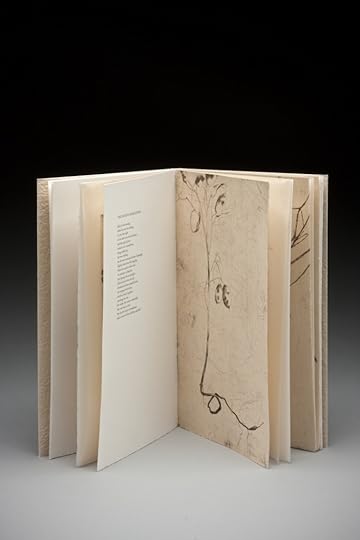
Poems by Sarah Lantz. Chine colle etchings by Sarah Horowitz. Remembrance by Eleanor Wilner. 2010. 15 x 9 inches with slipcase, edition of 25.
Sarah’s current show features a collection of dyed papers, some dyed a long time ago, others dyed for the show, some antique Japanese papers she’s collected, and some new ones from Hiromi Paper’s kozo color line.
I hope those of you reading this in Portland have a chance to see the show and meet Sarah! I’m jealous – let me know what you think of it!
Related Posts
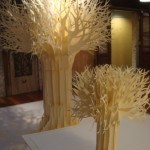 Baltimore!
Baltimore!
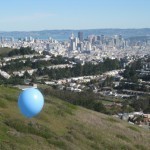 Hello from Codex!
Hello from Codex!
 Thread Loves Paper
Thread Loves Paper
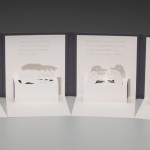 The Pop-Up Hand Shadow Book
The Pop-Up Hand Shadow Book
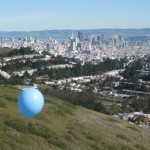 Side Effects of Codex
Side Effects of Codex
August 27, 2013
Orchestration
It delights me to witness and acknowledge the dedication and love that some people have for their craft (especially when it is also my craft). About a year ago, artist Mary Ellen Long invited me to be in a group show in Durango, a city in the SW corner of Colorado.
Washi and Other Ephemera: The Art of Hand Papermaking opened last Friday, featuring the work of ten nationally recognized paper artists. I did not get to attend the opening but will see the show later in September when I travel to Durango to teach a workshop.
I’m sorry I missed the performance amidst the works at the opening reception (but look forward to seeing a video of it) as well as a Japanese papermaking demonstration and workshop by Timothy Barrett from the University of Iowa Center for the Book.

Tim Barrett shipped this Japanese papermaking vat all the way from Iowa!
Mary Ellen and the staff at the Durango Arts Center put together a series of workshops in conjunction with the exhibition which will take place over the next three weekends. I’m looking forward to be teaching Illuminated Paper Structures at the center on Saturday, September 14th.
The exhibition is on view through September 28th. Hats off to Mary Ellen for conducting and the Durango Arts Center for orchestrating so many ways of bringing paper to the people of Southwest Colorado!
Related Posts
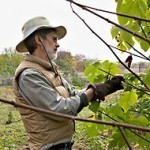 Boston
Boston
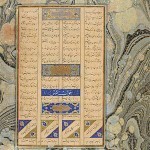 My 10 Top Paper Picks
My 10 Top Paper Picks
 Support Hand Papermaking!
Support Hand Papermaking!
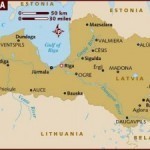 Papermaking in Latvia
Papermaking in Latvia
 Baltimore!
Baltimore!
August 6, 2013
On the Papermaking Farm
What a treat it has been to spend the past few days at Hook Pottery Paper in LaPorte, Indiana with my papermaking friend Andrea Peterson, her potter husband Jon Hook and their teenage sons Ry and Lu.
They millk their goats and make goat cheese.

Ry and a goat.
and collect 2 dozen eggs a day from their chickens.
They eat home grown food from their garden each meal.
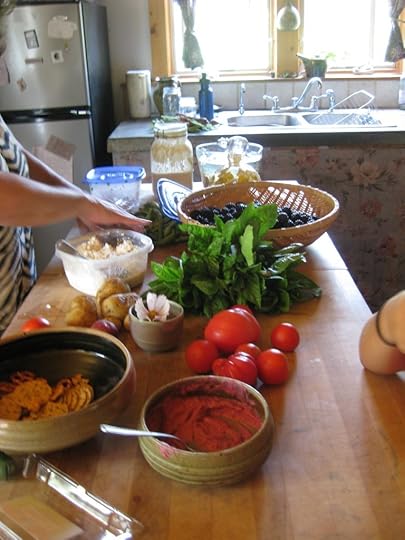 Andrea is a papermaker and Jon a potter. I taught a weekend workshop on watermarking in Andrea’s studio, and we all enjoyed the indoor/outdoor summer papermaking set-up.
Andrea is a papermaker and Jon a potter. I taught a weekend workshop on watermarking in Andrea’s studio, and we all enjoyed the indoor/outdoor summer papermaking set-up.
We created watermarks using strapping tape and buttercut.
and fabric paint.
 And after a hard days work we baked pizza in the bread oven!
And after a hard days work we baked pizza in the bread oven!
Hook Pottery Paper’s store is open every weekend and they offer workshops throughout the year. They even have a residency program with a visiting artist suite, where artists can stay while they create artwork under the technical supervision of Andrea and Jon.
There are not that many places that you can go and spend focused time making paper. Tell us about your papermaking residency experiences.
Related Posts
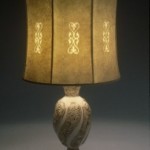 Watermarks
Watermarks
 My 10 Top Paper Picks
My 10 Top Paper Picks
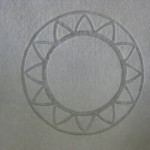 Hook Pottery Paper
Hook Pottery Paper
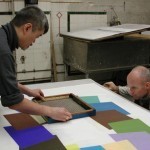 Fond Memories
Fond Memories
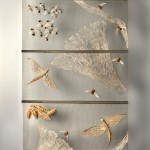 Artist Profile: Jill Powers
Artist Profile: Jill Powers
July 23, 2013
On Sale! The Papermaker’s Studio Guide
Just a quick note today. Click this link to read all about the Papermaker’s Studio Guide DVD sale which is running now through the end of July.
A few tidbits about the DVD:
It is a visual companion to The Papermaker’s Companion.
It consists of 60 minutes of content, ranging from how to set up your studio, to how to make paper, to how to make a watermark, paint with pulp and more.
You’ll save $10 if you order by July 31st (and $30 if you order two copies)!
Please spread the word and enjoy the sale!
Related Posts
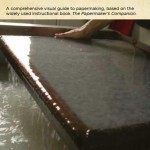 A Sale Is Coming!
A Sale Is Coming!
 A New Paper = For the Birds!
A New Paper = For the Birds!
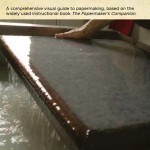 The Papermaker’s Studio Guide
The Papermaker’s Studio Guide
 The Papermaker’s Wet Floor
The Papermaker’s Wet Floor
 10: Paper Jewelry + A Giveaway
10: Paper Jewelry + A Giveaway
July 16, 2013
A Sale Is Coming!
Due to the generosity of The Celebration Foundation in Portland (for seed money) and Storey Books and Rockport Publishers (my publishers who helped pay the production costs) I have a surplus of the DVD I produced last fall, The Papermaker’s Studio Guide.
In honor of downsizing (we’ve just purchased a condo and there is no storage space) I’m selling my excess inventory at a reduced rate so that I don’t have to store the boxes of DVDs in my studio!
Have you seen the trailer for the DVD?
Trailer for The Papermaker’s Studio Guide.
Here is a sneak peak at one of the how-to chapters:
Sneak Peak: Papermaker’s Studio Guide DVD Chapter 1: Getting Equipped from Ian Lucero on Vimeo.
The DVD closely follows the content in my book, The Papermaker’s Companion.
I would love to hear your comments/feedback/criticism about the trailer or the entire DVD. Post a comment below or an e-mail to helen@helenhiebertstudio.com. Thanks!
And please stay tuned for sale details later this week!
Related Posts
 The Papermaker’s Studio Guide
The Papermaker’s Studio Guide
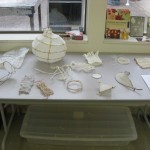 Abaca Workshop
Abaca Workshop
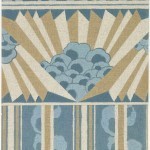 Paper Walls & Windows
Paper Walls & Windows
 On the Bookshelf
On the Bookshelf
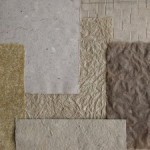 Artist Profile: Jenny Pinto
Artist Profile: Jenny Pinto
July 9, 2013
Another Giveaway!
Last week I typed about my next giveaway. I’m hoping to tempt you to make and share one of the projects in my book, Playing With Paper (a spin-off from a project qualifies too – creative twists are encouraged)!
To enter the giveaway, just e-mail a picture of your project to helen@helenhiebertstudio.com. You will be entered in a drawing to win a copy of the book and an Interchangeable Ring – a featured project in the book. BTW, I’m teaching a workshop in Indianapolis August 10/11. We might sneak in a project there as well.

Interchangeable Ring featured in Playing With Paper
If you are willing, I will add your image to the Playing With Paper Project page on Pinterest!
The deadline is September 1, 2013 (which gives you time to get a copy of the book, grab your supplies and whip out a project). Please pass the word on to all of your paper loving friends! Last week I received an e-mail from a reader who purchased two copies of the book and gave one to a friend. The two of them are going to get together and make a project.
The paper topper on the ring (which is made of 8 origami circles connected with double-side tape) is attached to a magnet, which connects to the metal ring base. I love attachments and connections. In fact, I taught a course one semester called Attachments & Connections at the Oregon College of Art & Craft in which we created joints by welding, wood joinery, magnets, stitching, stapling and everything in between.
In a similar vein, I love things that collapse and expand. Have I shown you my latest book, Handle With Care? It is an inflatable paper structure. That’s right – it is filled with air. I constructed it flat and then inflated it. You can make all kinds of shapes – not just circles! Check out some of the crazy shapes that you can make and inflate on this website (sorry, it is in Spanish).
[image error]On Writing Books – Part Two
July 2, 2013
Playing With Paper Projects
I’m curious to know whether you have had a chance to try any of the projects in my book Playing With Paper? I’d love to see and share your creative ideas! But seriously, you can be honest and say no – I have plenty of books on my own shelf that serve purely to inspire.
For those of you who’d like to try making one of the projects in Playing With Paper, I’ve decided to host a giveaway to entice and prompt you: see below for details.
When I was in Portland recently, I received this lovely little gift from Carol Dubosch, who came to my lecture at the library (where my artists books are on view now through July 31 – in the John Wilson Room at the Central Library).
She made this miniature version of the Diagonal Pocket Folder, which Hedi Kyle contributed to the book – just the size to hold a business card!
Here is the cover, adorned with calligraphy. (BTW, I’m looking forward to seeing Carol and her calligraphy friends at the upcoming calligraphy conference in Colorado Springs! I will be selling papers at the vendor fair on July 24th).
What do you like to make? During the holidays, I love to make these window stars, which I learned to make years ago when my daughter attended a Waldorf preschool. These make great gifts and are super easy to mail!
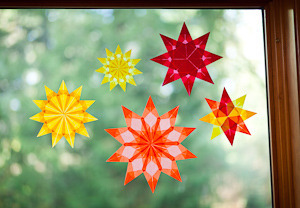
Photo by Stephen Funk
I also love weaving paper. When I started making lamps, I discovered that styrene (the plastic backing on lampshades) could be cut and used as a mini cutting mat. Here’s a sample of a paper weaving that I created. In the book, you learn how to cut windows in the paper – using styrene – to allow more light through.
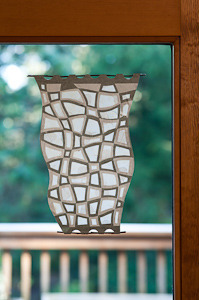
Photo by Stephen Funk
Steve Pittelkow (marbler extraordinaire) created this table runner after receiving his copy of the book.
The Envelope Lantern is a paper adaptation of a stained glass window. Here’s the project that is featured in the book.
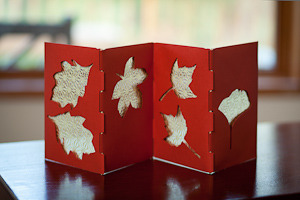
Photo by Stephen Funk
And an adaptation by a student that took my workshop at the Sitka Center for Art & Ecology last summer.
In 2001, I developed this Party Light for a lantern festival in Portland. We hosted workshops around the city so that people could create their own lanterns for the walk; needless to say, it was a luminous event! This project is super simple – reed is wrapped around a yogurt container and paper is collaged onto the form. After the glue dries, you simply remove the yogurt container and add a hanger.
Here is an adaptation on the project created by another student at Sitka last summer. She used her own nature printed paper.
Okay, it’s your turn! Send me a picture of a project you create from my book. The deadline is September 1, 2013. I’m giving you a couple of months in case you need time to get the book from the library, or to order a copy (get your autographed copy here). Your name will be entered in a drawing to win an Interchangeable Ring (also a project featured in the book) plus a copy of Playing With Paper. I’m reserving the right to change these rules slightly (don’t worry, it will be for the better if it happens) and I’ll announce any changes right here on the blog.
Please tell your creative friends who like to play with paper!
Now don’t be shy. I won’t share your image if you don’t want me to, but my hope is that we can create a Pinterest page featuring your projects!
Related Posts
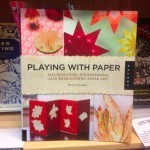 A Peak Inside of Playing With Paper
A Peak Inside of Playing With Paper
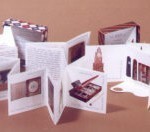 3: Paper & Books
3: Paper & Books
 The Pop-Up Hand Shadow Book
The Pop-Up Hand Shadow Book
 10: Paper Jewelry + A Giveaway
10: Paper Jewelry + A Giveaway
 Playing with Paper
Playing with Paper




